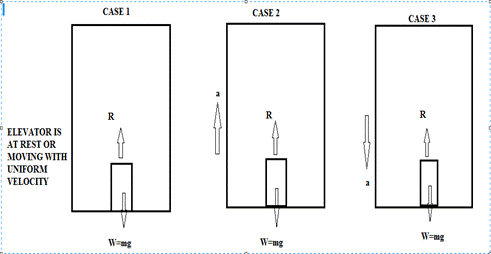
Concept explainers
What two forces act on you in a moving elevator? When are these forces equal in magnitude, and when are they not?
The two forces act on a person in a moving elevator. Also, the state the condition for the forces to be equal and unequal.
Explanation of Solution
Introduction:
According to Newton’s third law there is always equal and opposite reaction, for every action.
A person is in an elevator, which can move upward, downward and can be at rest.

As shown in the figure for the case 1, when the elevator is at rest or moving with uniform velocity then the two forces, W and R are equal.
For the case 2, the elevator is moving with an acceleration a in upward direction, in that case the net force on mass m is,
And for the case 3, as the elevator is moving with acceleration a in downward, the net force on mass m is,
Hence, for the case 2 and 3, mg and R are not equal.
But for the case 1, acceleration of the elevator is zero, a= 0
So, here
The two forces are force, W due to gravity on the person and the reaction force R which is the normal force from the ground surface of the elevator on the person.
When the elevator is moving with uniform velocity or in rest position, then these two forces will be equal and when the elevator is moving with acceleration in upward or downward then these two forces will be unequal.
Chapter 13 Solutions
Conceptual Physics: The High School Physics Program
Additional Science Textbook Solutions
Microbiology with Diseases by Body System (5th Edition)
Chemistry (7th Edition)
Cosmic Perspective Fundamentals
Human Anatomy & Physiology (2nd Edition)
Applications and Investigations in Earth Science (9th Edition)
Introductory Chemistry (6th Edition)
 College PhysicsPhysicsISBN:9781305952300Author:Raymond A. Serway, Chris VuillePublisher:Cengage Learning
College PhysicsPhysicsISBN:9781305952300Author:Raymond A. Serway, Chris VuillePublisher:Cengage Learning University Physics (14th Edition)PhysicsISBN:9780133969290Author:Hugh D. Young, Roger A. FreedmanPublisher:PEARSON
University Physics (14th Edition)PhysicsISBN:9780133969290Author:Hugh D. Young, Roger A. FreedmanPublisher:PEARSON Introduction To Quantum MechanicsPhysicsISBN:9781107189638Author:Griffiths, David J., Schroeter, Darrell F.Publisher:Cambridge University Press
Introduction To Quantum MechanicsPhysicsISBN:9781107189638Author:Griffiths, David J., Schroeter, Darrell F.Publisher:Cambridge University Press Physics for Scientists and EngineersPhysicsISBN:9781337553278Author:Raymond A. Serway, John W. JewettPublisher:Cengage Learning
Physics for Scientists and EngineersPhysicsISBN:9781337553278Author:Raymond A. Serway, John W. JewettPublisher:Cengage Learning Lecture- Tutorials for Introductory AstronomyPhysicsISBN:9780321820464Author:Edward E. Prather, Tim P. Slater, Jeff P. Adams, Gina BrissendenPublisher:Addison-Wesley
Lecture- Tutorials for Introductory AstronomyPhysicsISBN:9780321820464Author:Edward E. Prather, Tim P. Slater, Jeff P. Adams, Gina BrissendenPublisher:Addison-Wesley College Physics: A Strategic Approach (4th Editio...PhysicsISBN:9780134609034Author:Randall D. Knight (Professor Emeritus), Brian Jones, Stuart FieldPublisher:PEARSON
College Physics: A Strategic Approach (4th Editio...PhysicsISBN:9780134609034Author:Randall D. Knight (Professor Emeritus), Brian Jones, Stuart FieldPublisher:PEARSON





